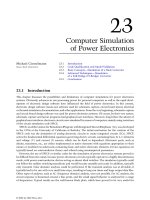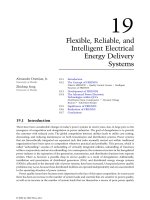Tài liệu Power Electronic Handbook P3 ppt
Bạn đang xem bản rút gọn của tài liệu. Xem và tải ngay bản đầy đủ của tài liệu tại đây (82.77 KB, 4 trang )
© 2002 by CRC Press LLC
3
AC-AC Conversion
3.1 Introduction
3.2 Cycloconverters
3.3 Matrix Converters
3.1 Introduction
AC-AC converters as shown in Fig. 3.1 are frequency converters. They produce an AC voltage in which both
the frequency and voltage can be varied directly from the AC line voltage, e.g., from a 60- or 50-Hz source.
There are two major classes of AC-AC, or so-called direct static frequency converters, as shown in Fig. 3.1.
1. Cycloconverters, which are constructed using naturally commutated thyristors. The commutation
voltage is ensured by the supply voltage. These are so-called line commutated converters.
2. Matrix converters, which are constructed using full-controlled static devices, such as transistors
or GTOs (gate turn-off thyristors).
3.2 Cycloconverters
In Figs. 3.2 and 3.3, the two typical types of cycloconverters are presented. In the first case there are
two three-phase midpoint controlled rectifiers connected back to back. The second case shows two
three-phase bridge rectifier converters connected back to back. Both are used for three-phase to three-
phase conversion. In Fig. 3.4 the single-phase output voltage and current waves are presented for the
FIGURE 3.1
Classification of frequency converters.
Frequency
converters
AC-AC Converters
(direct frequency
converters)
Cyclo-
converters
Matrix
converters
AC-DC-AC
Converters
Sándor Halász
Budapest University of Technology
and Economics
© 2002 by CRC Press LLC
bridge rectifier circuits. The output voltage
V
a
and current
i
a
have
V
a
1
and
i
a
1
fundamental components
with
φ
1
phase displacement and numerous harmonics. Because of the load inductance, the current harmonics
will be significantly lower than the voltage harmonics. The firing angles are
α
P
and
α
N
for the
p
and
n
converters, respectively. In general, the controls are designed so that only the thyristors of either the
p
or
n
converter is firing, which produces a current in the desired direction. During this period the other
converter is blocked. When the current changes direction, both converters must be blocked for a short time.
It is possible to operate without blocking the converters. In this case, their average voltage must be
the same, and therefore the relation
α
p
=
180
−
α
n
is valid. However, additional inductances are necessary
to limit the circulating currents between two converters since the instantaneous voltages of the two
converters differ from one another.
FIGURE 3.2
Cycloconverter scheme with three-phase midpoint controlled rectifier.
FIGURE 3.3
Cycloconverter scheme with three-phase bridge controlled rectifier.
p
converter
n
converter
a bc
i
a
R
S
T
LOAD
~V ; 60 Hz
−
RST
Transformer
p
converter
n
converter
a
i
a
bc
LOAD
© 2002 by CRC Press LLC
The phase control of the
p
and
n
converters is modulated by a sine or trapezoidal wave. The content
of the harmonics for sine modulation is lower; however, the maximum value of the output voltage is
lower than that for trapezoidal modulation. During every cycle of the output voltage both of the converters
must work as rectifiers and inverters.
The shape of the output voltage goes from bad to worse with an increase in the output voltage and
the output frequency. If the frequency reaches the well-defined value the current harmonics become
unacceptable. This frequency is usually 33% of supply frequency for three-phase midpoint (Fig. 3.2) and
50% for three-phase bridge (Fig. 3.3) converters.
The cycloconverter is usually used for three-phase, high-power, low-speed synchronous motor drives
and rarely employed for induction motor drives.
3.3 Matrix Converters
The three-phase to three-phase matrix converter is presented in Fig. 3.5. Using the bidirectional switches,
any phase of the load can be connected to any phase of the input voltage, e.g., the zero value of the load
phase voltages is maintained by connecting all the load phases to the same input phase. Using pulse-width
FIGURE 3.4
Voltage and current vs. time for cycloconverter with three-phase bridge converters.
FIGURE 3.5
Three-phase to three-phase matrix converter.
V
i
a
i
a1
ω
1
t
ω
1
t
α
n
φ
1
n
inverter
p
inverter
p
and
n
blocked
p
and
n
blocked
p
rectifier
n
rectifier
n
blocked
p
blocked
α
p
V
a
V
a
1
i
Nine
independent
bidirectional
switches
Load
(variable
voltage
and
variable
frequency)
R
S
T
c
b
a
(60 HZ)
© 2002 by CRC Press LLC
modulation techniques, the load voltage and the load frequency are controlled from zero to their max-
imum values. The maximum voltage is usually close to the input voltage, but the maximum frequency
can be several times that of the input frequency and is only limited by practical considerations. The
bidirectional switches must be capable of permitting current flow in either direction. In Fig. 3.6 one
possible configuration of the bidirectional switch is shown.
Matrix converters require the use of numerous switches and well-established control methods. Some
additional elements are necessary for the safe commutation of the bidirectional switches. These disad-
vantages of matrix converters prevent their use in industrial applications.
References
Guggi, L. and Pelly, B. R. 1976.
Static Power Frequency Changes,
John Wiley & Sons, New York.
Pelly, B. R. 1976.
Thyristor Phase-Controlled Converters,
John Wiley & Sons, New York.
FIGURE 3.6
Bidirectional switch.









